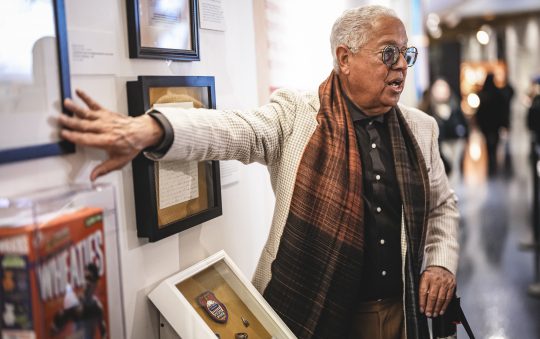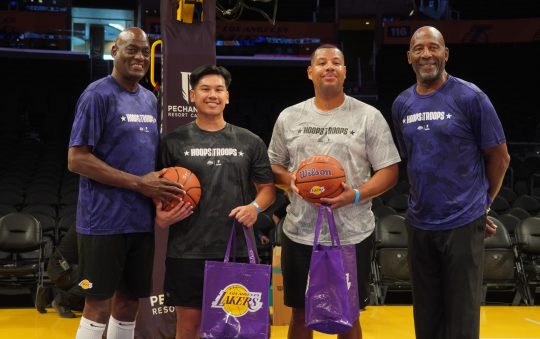
The Los Angeles Raiders and Los Angeles Rams both played at the Los Angeles Memorial Coliseum, and Marcus Allen (32) was one of many great black athletes to play professional football there.
By Jason Lewis
Sentinel Sports Writer
jasonl@lasentinel.net
With the Los Angeles City Council approving a tentative framework agreement with AEG to build an NFL stadium in Downtown, Los Angeles is one step closer to having an NFL team here for the first time since the Raiders and Rams left in 1995.
An entire generation has grown up without professional football here, but for several decades, Los Angeles residents were able to see some of the greatest players in the game play right here, and for black players, this is where it all started for them, as some of the pioneering black players opened the door for many great black players to showcase their talents here in Los Angeles.
Over a 55-year period, there were many great players to play here.
The first modern day professional black football players were not playing in the NFL, but in the Pacific Coast Professional Football League (PCPFL), which was not segregated, like the NFL was, and their biggest star was Kenny Washington, who was a dominant running back from UCLA.
One of Washington’s running mates at UCLA was Woody Strode. The two were denied entry into the NFL because they were black, so they opted for the PCPFL, where they both starred for the Hollywood Bears.
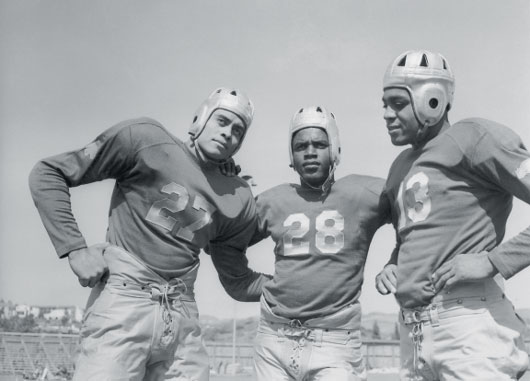 Washington and Strode led the Bears to a perfect season in 1941, defeating the Los Angeles Bulldogs three times that season. The Bulldogs featured Jackie Robinson, who also played in UCLA’s backfield with Washington and Strode.
Washington and Strode led the Bears to a perfect season in 1941, defeating the Los Angeles Bulldogs three times that season. The Bulldogs featured Jackie Robinson, who also played in UCLA’s backfield with Washington and Strode.
Washington had become a huge star on the west coast, as attendance increased in games that he played in. Even though he was not allowed to play in the NFL, his talents were well known.
“Considered by West Coast fans the most brilliant player in the U. S. last year, Washington cannot play major-league pro football because he is a Negro.” Time Magazine, 1940.
Robinson decided to turn to baseball in 1945, when he joined the Negro Leagues, but Washington and Strode continued with football, and would eventually break the color barrier in the sport in 1946, nearly a year before Robinson made his debut with the Brooklyn Dodgers.
When the Cleveland Rams decided to move to Los Angeles in 1946, the commissioners of the Los Angeles Coliseum stipulated as part of the agreement that the team be integrated. The Rams signed Washington and Strode, ending the NFL’s 12-year-old color barrier rule.
Washington only played three seasons for the Rams, and Strode one, but their impact on the NFL was lasting. Currently about two thirds of the league is black.
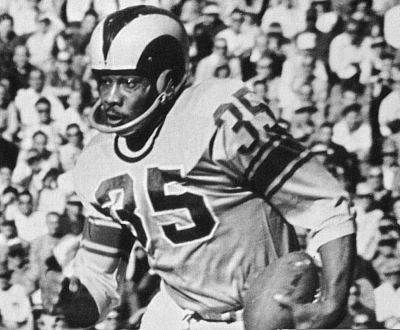 Not long after Washington and Strode, running back Paul “Tank” Younger emerged as a star in Los Angeles. He was named Black College Football’s Player of the Year in 1948 when he played at Grambling State, but he was undrafted by a NFL team. The Rams signed him as a free agent, making him the first NFL player from a Historically Black College and University (HBCU). He was a member of the “Bull Elephant” backfield with the Rams, which also featured fellow black running back “Deacon” Dan Towler, who was selected to four Pro Bowls. Younger was also named to the Pro Bowl four times.
Not long after Washington and Strode, running back Paul “Tank” Younger emerged as a star in Los Angeles. He was named Black College Football’s Player of the Year in 1948 when he played at Grambling State, but he was undrafted by a NFL team. The Rams signed him as a free agent, making him the first NFL player from a Historically Black College and University (HBCU). He was a member of the “Bull Elephant” backfield with the Rams, which also featured fellow black running back “Deacon” Dan Towler, who was selected to four Pro Bowls. Younger was also named to the Pro Bowl four times.
In 1951, Younger became the first black athlete to play in the NFL’s All Star game and he went on to become the first black assistant general manager, when he was given the position with the San Diego Chargers in 1975. Younger and Towler helped the Rams win the world championship in 1951. Also on that championship team was Woodley Lewis, who attended Manual Arts High School. Lewis was the first black player to play in the Cotton Bowl when he was a player for the University of Oregon, and he set the Rams rookie record for interceptions in 1950 with 12. Dick “Night Train” Lane broke that record two years later when he had 14 interceptions, which was also an NFL record that still stands today
In 1959 the Rams drafted Dick Bass, who rushed for over 1,000 yards twice and was selected to three Pro Bowls during his career. The Rams were not very good over the course of his 10-year career, but he was a bright spot for the team. He went on to work as the Rams color analyst for the Rams radio broadcasts from 1977 to 1986.
Three of the Rams’ famed Fearsome Foursome defensive line players were black. David “Deacon” Jones, Rosey Grier, and Lamar Lundy formed three fourths of one of the greatest defensive lines in pro football history, with the fourth member being Merlin Olsen.
 Jones, along with Olsen, is a member of the NFL Hall of Fame. He specialized in tackling the quarterback, and he coined the phrase “sack.” Nicknamed the “Secretary of Defense,” Jones is one of the greatest defensive players ever to play football, and the Los Angeles Times called him the “Most Valuable Ram of All Time.” Jones was named to eight Pro Bowls and All Pro teams. He is a member of the NFL 75th Anniversary All Time Team, the NFL 1960s All Decade Team, and he was named NFL Defensive Player of the year twice.
Jones, along with Olsen, is a member of the NFL Hall of Fame. He specialized in tackling the quarterback, and he coined the phrase “sack.” Nicknamed the “Secretary of Defense,” Jones is one of the greatest defensive players ever to play football, and the Los Angeles Times called him the “Most Valuable Ram of All Time.” Jones was named to eight Pro Bowls and All Pro teams. He is a member of the NFL 75th Anniversary All Time Team, the NFL 1960s All Decade Team, and he was named NFL Defensive Player of the year twice.
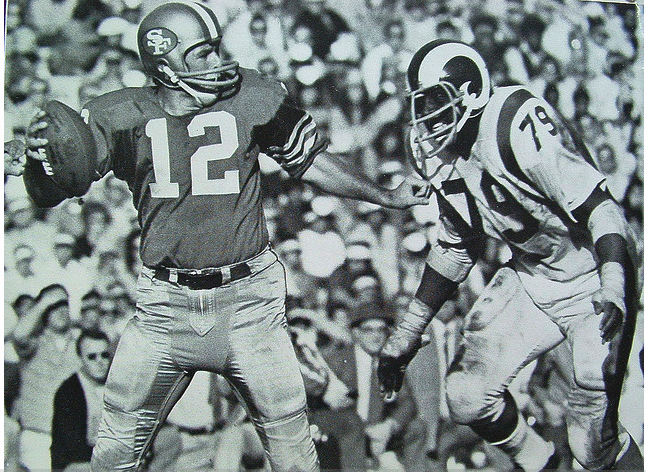 Defensive tackle Coy Bacon started his career in 1964 with the Houston Oilers, but it was not until 1969, when Roger Brown was injured, that he was able to see playing time with the Rams. The following year Lamar Lundy retired, which allowed Bacon to start for the next three seasons for the Rams at right defensive tackle. Bacon was named All Pro in 1971 and 1972, and he finished his career with 130 sacks.
Defensive tackle Coy Bacon started his career in 1964 with the Houston Oilers, but it was not until 1969, when Roger Brown was injured, that he was able to see playing time with the Rams. The following year Lamar Lundy retired, which allowed Bacon to start for the next three seasons for the Rams at right defensive tackle. Bacon was named All Pro in 1971 and 1972, and he finished his career with 130 sacks.
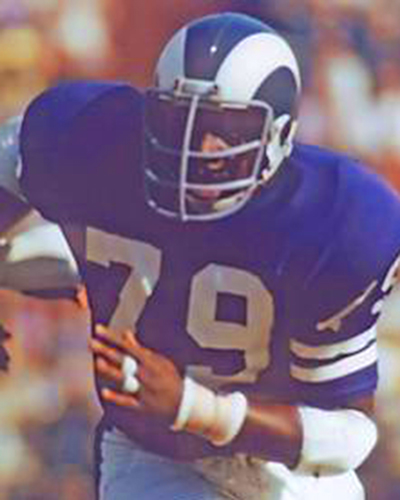 Charles Cowan played for 16 years at left tackle for the Rams, starting in 1966, along side Tom Mack, who is a member of the Hall of Fame. Cowan was a huge intimidating presence who was selected to the Pro Bowl three times. The Rams made it to the NFC Championship game twice with the help of Cowan.
Charles Cowan played for 16 years at left tackle for the Rams, starting in 1966, along side Tom Mack, who is a member of the Hall of Fame. Cowan was a huge intimidating presence who was selected to the Pro Bowl three times. The Rams made it to the NFC Championship game twice with the help of Cowan.
Linebacker Isiah “Butch” Robertson was drafted by the Rams in the first round of the 1971 NFL Draft, which was a great pick. Robertson hit the ground running, as he was voted the NFL Defensive Rookie of the Year, and he was voted to the Pro Bowl and All Pro teams six times in the eight seasons that he played for the Rams. He was selected to the All Conference team each year that he played in Los Angeles. Robinson’s combined size, strength, quickness (4.6 40) and toughness allowed him to make game breaking plays, and by 1973, he was known as one of the best linebackers in football.
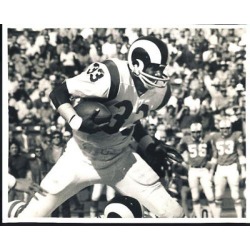 Willie Ellison did not have as stellar of a career as other Los Angeles players, but for one game in 1971, he was the best ever up until that point. Ellison set the NFL’s single game rushing record by running for 243 yards. The NFL record was held by Jim Brown, who rushed for 237 yards in a game in 1957, and the pro football record was held by Cookie Gilchrist, who rushed for 243 yards for the New York Jets of the AFL. Ellison was named to the only Pro Bowl of his career that season.
Willie Ellison did not have as stellar of a career as other Los Angeles players, but for one game in 1971, he was the best ever up until that point. Ellison set the NFL’s single game rushing record by running for 243 yards. The NFL record was held by Jim Brown, who rushed for 237 yards in a game in 1957, and the pro football record was held by Cookie Gilchrist, who rushed for 243 yards for the New York Jets of the AFL. Ellison was named to the only Pro Bowl of his career that season.
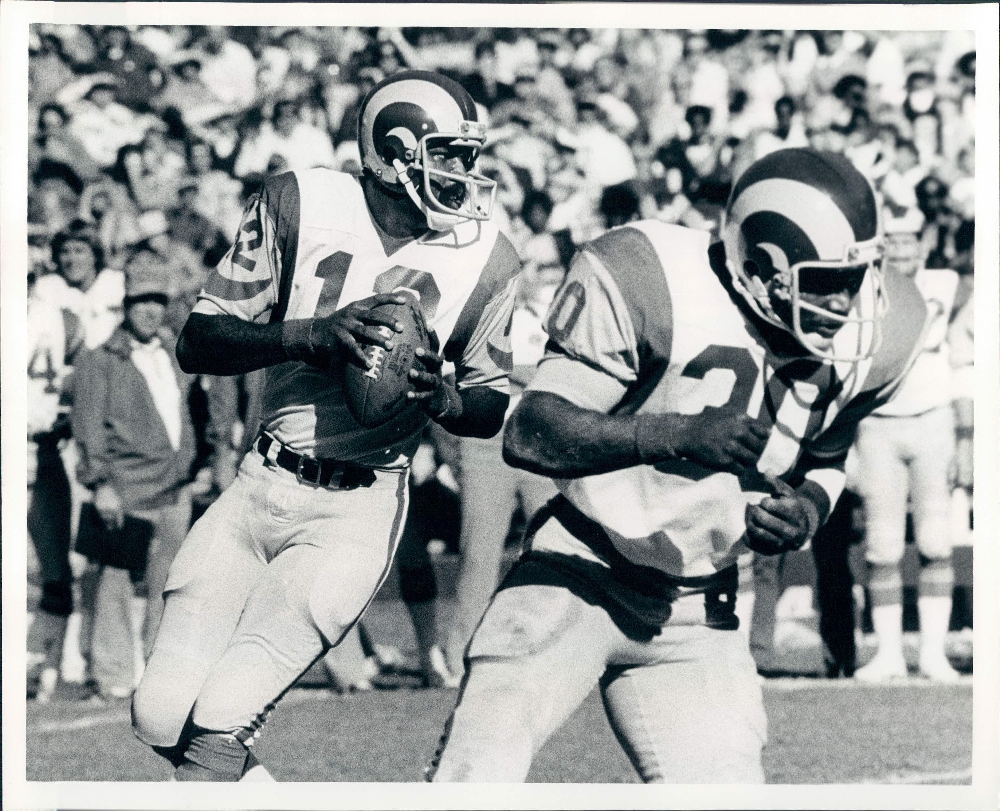 James Harris, who was the first black quarterback to begin a season as the starter when he played for the Buffalo Bills, signed with the Rams in 1973. By 1974 he was the starting quarterback and he led them to their second straight NFC West title, and to their first playoff victory since 1951. Harris then became the first black quarterback to start in a conference championship game, which the Minnesota Vikings won with the help of some controversial officiating. Harris was named to the NFL Pro Bowl that year and he was named the game’s MVP. Harris, who played college football at Grambling State, is currently a Senior Personnel Executive with the Detroit Lions.
James Harris, who was the first black quarterback to begin a season as the starter when he played for the Buffalo Bills, signed with the Rams in 1973. By 1974 he was the starting quarterback and he led them to their second straight NFC West title, and to their first playoff victory since 1951. Harris then became the first black quarterback to start in a conference championship game, which the Minnesota Vikings won with the help of some controversial officiating. Harris was named to the NFL Pro Bowl that year and he was named the game’s MVP. Harris, who played college football at Grambling State, is currently a Senior Personnel Executive with the Detroit Lions.
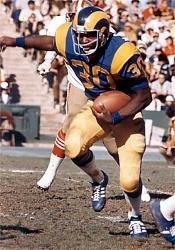 Lawrence McCutcheon powered the Rams running game from 1972 to 1979. He was selected to five Pro Bowl teams and one All Pro team, and in 1975 he set the single game postseason rushing record by running for 202 yards on 37 carries against the St. Louis Cardinals. That record has since been broken. He was the Rams running back in 1979, when the team made their only Super Bowl appearance while playing in Los Angeles. He threw a touchdown pass, giving the Rams a 19-17 lead over the Pittsburgh Steelers. But the Rams would eventually lose the game 31-19.
Lawrence McCutcheon powered the Rams running game from 1972 to 1979. He was selected to five Pro Bowl teams and one All Pro team, and in 1975 he set the single game postseason rushing record by running for 202 yards on 37 carries against the St. Louis Cardinals. That record has since been broken. He was the Rams running back in 1979, when the team made their only Super Bowl appearance while playing in Los Angeles. He threw a touchdown pass, giving the Rams a 19-17 lead over the Pittsburgh Steelers. But the Rams would eventually lose the game 31-19.
Jackie Slater was drafted by the Rams in 1976, and went on to become one of the most dominant player to ever play for the Rams. At left tackle, he played 20 seasons with the Rams, and on one end of his career he was teammates with Hall of Famers Merlin Olsen and Jack Youngblood, and at the other end of his career he was teammates with Jerome Bettis and Issac Bruce. Slater’s first year as a starter in 1979, the Rams went to the Super Bowl, and in 1983 he anchored an offensive line that allowed a league low 23 sacks, while paving the way for Eric Dickerson to rush for a rookie record 1,808 yards. Slater was selected to seven Pro Bowls and was named All Pro five times. He is now a member of the NFL’s Hall of Fame.
When Eric Dickerson was drafted by the Rams in 1983, he immediately lit the league on fire, setting the rookie rushing record. In his second year he broke two of O.J. Simpson’s records. Dickerson set the single season rushing record with 2,105 yards and the most 100-yard games in a season with 11. During his five years with the Rams, Dickerson was named to the Pro Bowl and All Pro four times. After being traded to the Indianapolis Colts, he only made two Pro Bowls and one All Pro team.
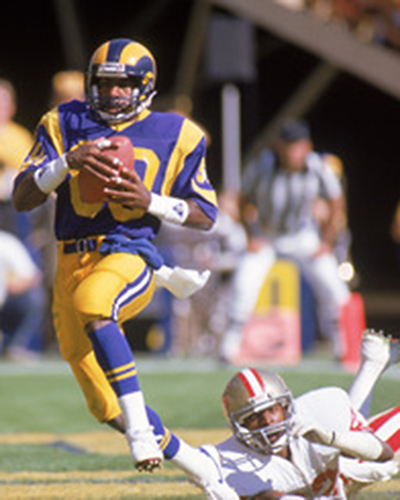 Over the course of Henry Ellard’s career with the Rams, which began in 1983, he was one of the best wide receivers in the league, as he was selected to three Pro Bowls and two All Pro teams. Hall of Fame cornerback Deion Sanders said that Ellard was one of the best wide receivers that he had to face. At the time of Ellard’s retirement he held the Rams franchise records for most receptions, receiving yards, 100-yard games, punt return average, and total offense.
Over the course of Henry Ellard’s career with the Rams, which began in 1983, he was one of the best wide receivers in the league, as he was selected to three Pro Bowls and two All Pro teams. Hall of Fame cornerback Deion Sanders said that Ellard was one of the best wide receivers that he had to face. At the time of Ellard’s retirement he held the Rams franchise records for most receptions, receiving yards, 100-yard games, punt return average, and total offense.
The Rams dominated Los Angeles football for 36 years, but in 1982 they had company when the Raiders moved from Oakland into the Los Angeles Coliseum. The first move that the Raiders made was to draft running back Marcus Allen, who won the Heisman trophy at USC while helping them win a National Championship.
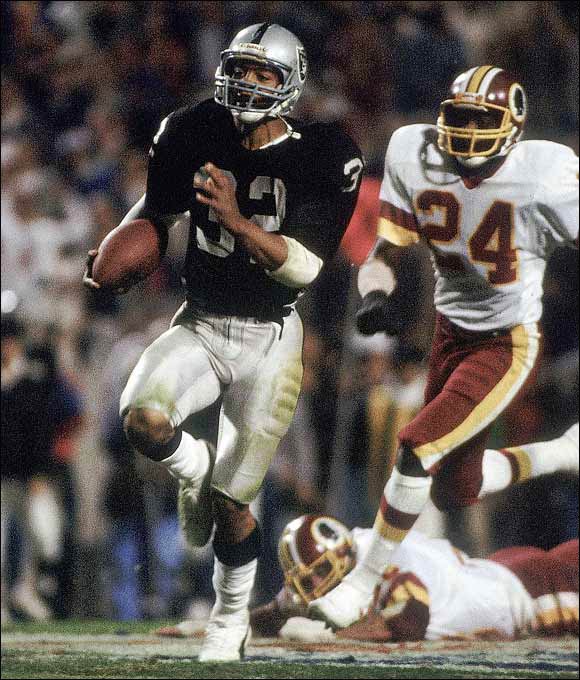 Allen was a star from the get go, as he was named Offensive Rookie of the Year. The very next year he helped the Raiders win the Super Bowl, and he was named the MVP of the game after rushing for 191 yards.
Allen was a star from the get go, as he was named Offensive Rookie of the Year. The very next year he helped the Raiders win the Super Bowl, and he was named the MVP of the game after rushing for 191 yards.
Allen was named the NFL’s MVP in 1985 when he rushed for 1,759 yards. But after that it all went south for Allen. A bad relationship with Al Davis and injuries took all the star power away from Allen, who eventually left for Kansas City. While playing for the Raiders, Allen was named to five Pro Bowls and named to the All Pro team three times. He is now a member of the Hall of Fame.
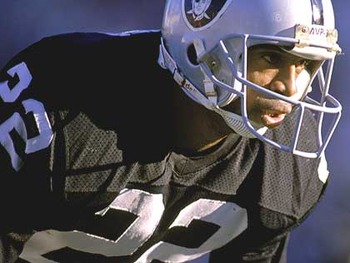 The Raiders brought over a very good team with them from Oakland, and the addition of cornerback Mike Haynes late in the 1983 season made them even better. They acquired Haynes from the New England Patriots with five games remaining in regular season, and he had an interception in their Super Bowl victory later that year. Haynes was named to the Pro Bowl three times while playing with the Raiders, and nine overall. He was named to the 1980s All Decade Team and to the NFL 75th Anniversary All Time Team. He is now a member of the NFL Hall of Fame.
The Raiders brought over a very good team with them from Oakland, and the addition of cornerback Mike Haynes late in the 1983 season made them even better. They acquired Haynes from the New England Patriots with five games remaining in regular season, and he had an interception in their Super Bowl victory later that year. Haynes was named to the Pro Bowl three times while playing with the Raiders, and nine overall. He was named to the 1980s All Decade Team and to the NFL 75th Anniversary All Time Team. He is now a member of the NFL Hall of Fame.
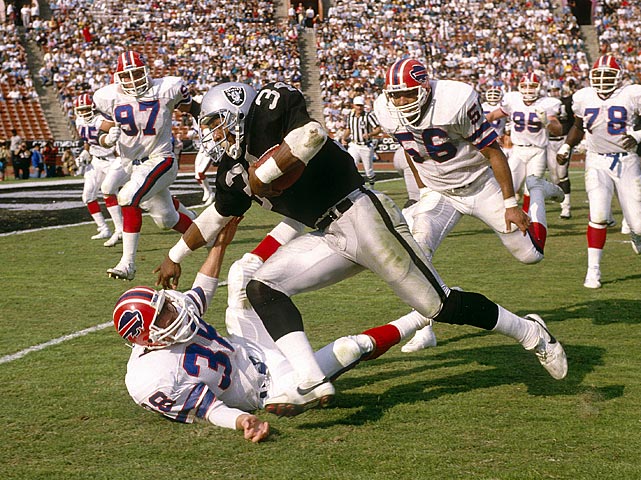 In 1987 the Raiders drafted one of the most unique and athletically gifted individuals ever to play modern day sports when they landed running back Bo Jackson. Jackson was one of the most electrifying players ever to play football, and he put fear in most defenses that he played against because he was big and strong enough to run over players, and fast enough to blow right by them. But he was also a baseball player, which took him away from the beginning portions of each football season. He only made one Pro Bowl before he had a career ending injury.
In 1987 the Raiders drafted one of the most unique and athletically gifted individuals ever to play modern day sports when they landed running back Bo Jackson. Jackson was one of the most electrifying players ever to play football, and he put fear in most defenses that he played against because he was big and strong enough to run over players, and fast enough to blow right by them. But he was also a baseball player, which took him away from the beginning portions of each football season. He only made one Pro Bowl before he had a career ending injury.
 The last star professional football player in Los Angeles was Tim Brown. Most of Brown’s greatness happened while playing in Oakland, but he did play eight seasons with the Raiders before they moved in 1995. Injuries hurt Brown early in his career, and playing behind veteran wide receivers, but he was selected to the Pro Bowl four times before the move to Oakland.
The last star professional football player in Los Angeles was Tim Brown. Most of Brown’s greatness happened while playing in Oakland, but he did play eight seasons with the Raiders before they moved in 1995. Injuries hurt Brown early in his career, and playing behind veteran wide receivers, but he was selected to the Pro Bowl four times before the move to Oakland.
Los Angeles has a very rich history of black professional football players, and with a team returning sooner than later, that history will continue to grow.
Check out the Sentinel Sports Section on Facebook and Twitter.
Sentinel Sports Section Facebook page:
http://www.facebook.com/?ref=logo#!/pages/Los-Angeles-Sentinel-Sports-Section/137328139648009
Sentinel Sports Twitter page:



